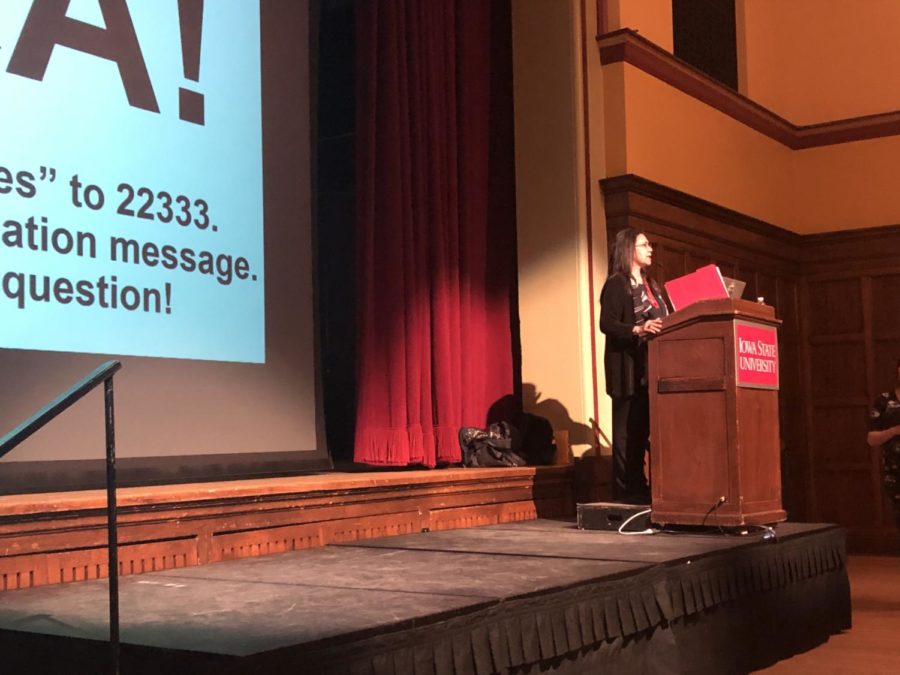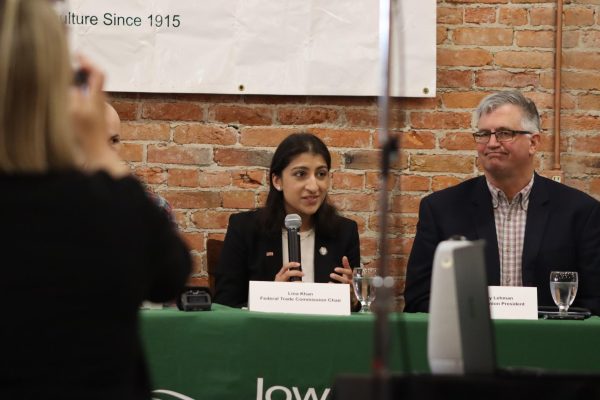Indigenous activist speaks on representation in children’s literature
February 26, 2020
An activist for the representation and misrepresentation in Native people’s lives through children and young adult literature presented a lecture Wednesday.
Debbie Reese, who is a scholar, author and activist of indigenous children’s literature and the teaching of indigenous peoples and history, was the speaker for the lecture, which packed the Great Hall of the Memorial Union.
The Great Hall was packed with people of all ages, from Iowa State students, faculty and staff to Ames community members.
The lecture started off with an acknowledgment of the land that Iowa State stands on.
“Before this site became Iowa State University, it was the ancestral lands and territory of the Baxoje, or Ioway Nation,” according to the land acknowledgment on-screen at the lecture. “The United States obtained the land from the Meskwaki and Sauk nations in the Treaty of 1842.”
Reese started off her presentation by laying down four main talking points.
The first was Native nations were nations before the United States was a nation.
The second was “We are still here. And we are still nations, with nation-to-nation relationships, treaties, with the United States government.”
The third was characterizing traditional Native stories as “myths, legends and folktales” is sacrilegious.
The fourth was the emphasis of Reese’s work, and others, is education; the phrase “politically correct” doesn’t do justice to the work educators are doing.
Reese then moved in her story. She is from the Nambé Owingeh Nation, which is a pueblo nation in New Mexico, which is one of 19 Pueblo nations in New Mexico.
Reese said people should never label Native nations as cultures because they are nations. Every Native nation is sovereign and has a system of governance; they are not just a “culture.”
Reese also said she wanted to clarify a Native nation’s traditional clothing is not a costume; it is special clothing handed down from family members and should never be called a costume.
Reese then went on and discussed the history of the Pueblo people from 1540 to 1863. She said the Pueblo people had received three canes of power from three different nations, Spain, Mexico and the United States, that recognized the Pueblo Nation’s sovereignty at different times throughout history.
Reese’s major area of expertise is Indigenous representation in children’s literature, so after discussing the history of her people, she dived into the history of that representation.
The first book Reese discussed was “Orbis Pictus” by John Amos Comenius. This book was the first non-fiction book ever written for children. In one section of the book is an image with different depictions of Native people from around the world, with corresponding text below.
“The Indians, even to this day, worship the Devil,” according to the description of Native Americans in “Orbis Pictus.”
The next book Reese spoke about was “A Son of the Forest” by William Apess. This book described Apess’ view of Native people as scary, even though he was a Native person himself. This was because Apess was raised by a white family that told him stories about how Native people were scary and aggressive. Reese said that as Apess got older, he realized this fear was wrong and that the white people were actually the aggressors.
Reese went on to describe some of this aggression. One example was how white people would try to “Christianize and civilize” Native peoples, oftentimes against their will. The main way they would do this is by using “boarding schools” to remove Native culture from them and teach them how to be “civilized.”
Reese spoke of her two grandfathers; one was a white man with the last name of Yates while the other was a Native American man with the last name of Sakiestewa. Her Native American grandfather was sent to one of these boarding schools, and his last name was taken from him. He was given a more “common” name, Calvert, and many of Reese’s cousins carry that name.
“One of my grandfathers lost his name but kept his culture,” Reese said. “One of my grandfathers, his identity was never under threat.”
Reese then moved into the idea of names and how they are important. She said that all given names are special and very important because they are given for a reason and mean something to the person who gives it.
Reese brought up how one teacher used “Native American Names” worksheet in a class that encouraged the students to create names such as “Talks-Too-Much” or “No-Particular-Time,” which presents the idea that Native nations actually use these names and that “taking on a Native name” is a good thing to do.
The next book Reese discussed was “Little House on the Prairie” by Laura Ingalls Wilder, which was first published in 1935 and then published again in 1953. This is one of Reese’s least favorite books for many reasons.
Reese said the contents of the book are deeply problematic with multiple factual problems in the book, such as misrepresenting Native peoples as primitive and pretty naked, when that was in fact not the case.
Reese also said the story is presented as autobiographical when it is not because Wilder was two when she moved to “Indian Territory,” and the story is written from the perspective of a 7-year-old.
“I don’t want people using this book in classrooms, not because I’m trying to censor you but because you’re educators,” Reese said. “You’re charged with educating children, not misleading them with mythical and stereotypical content. That goes against what you as educators are expected to do.”
Another major part of Reese’s lecture was the idea of “#Own Voices.” The hashtag was coined by Corinne Duyvis, an author and cofounder and editor of Disability in Kidlit, a website that focuses on the portrayal of disability in children’s literature, in 2015.
The idea behind #OwnVoices is the protagonist and author share a marginalized identity to allow a truthful “insider perspective” into that identity.
Reese said there may be a problem with #OwnVoices when it comes to Native nations, such as when delving into the spiritual or cultural ways of another tribal nation. Authors may have to contend with pushback due to inaccuracies or perceived cultural appropriation.
To counteract that, Reese proposed a slight change by doing things like “#NambéVoices” to specify that the author and protagonist both share that specific identity.
Reese moved into this idea more by presenting the idea of “windows, mirrors, sliding glass doors” by Rudine Sims Bishop, a professor from Ohio State University. That idea states that windows allow vision into another culture, mirrors reflect back a shared culture and sliding glass doors allow for immersion into another culture.
Reese then pulled up an infographic showing different mirrors in children’s literature and who they represent. The majority of the mirrors, 50 percent, represented white children; 27 percent represented animals or other non-humans; 10 percent represented African American children; 7 percent represented Asian Pacific American children; 5 percent represented Latinx children; and only 1 percent represented Indigenous children.
To the “windows, mirrors, sliding glass doors,” Reese discussed with Bishop of adding “curtains” to the list because some things do not need to be shared because it is no one else’s business. Examples of various Native nations’ practices have been incorrectly shared by outsiders in various points in history, and curtains in these metaphorical windows may help with that.
Some good children’s books that Reese listed at the end of her lecture include: “We Are the Water Protectors” by Carole Lindstrom and Michaela Goade; “Fry Bread” by Kevin Maillard; “We Are Grateful” by Traci Sorell; “Mary and the Trail of Tears” by Andrea Rogers; “If I Ever Get Out of Here” by Eric Gansworth; and “Hearts Unbroken” by Cynthia Leitich Smith.
All of the books Reese mentioned were children’s and young adult literature written by Native authors and have a Native protagonist.
“We are after stacks and stacks of books,” Reese said. “Right now, there are not stacks and stacks of books. You have to help that happen, you have to buy books by Native writers, you have to go to the library and ask for the book, you have to be actively engaged so that we grow the stacks of books by Native writers.”

















